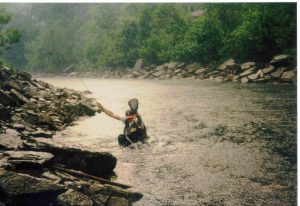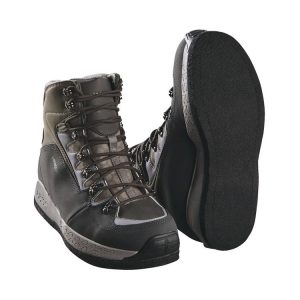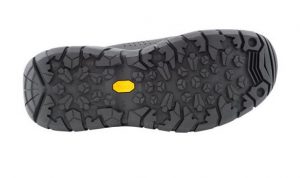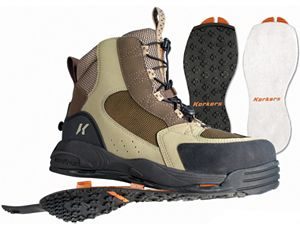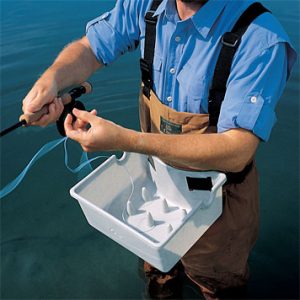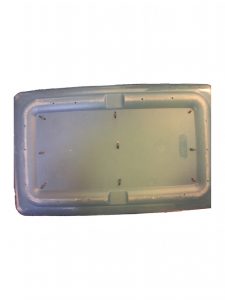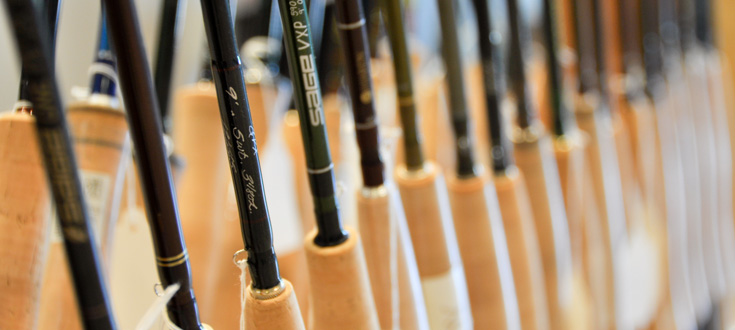 This should probably go without saying, but the fly rod is the tool used to cast the line when fly fishing. It is also used to manipulate line on the water after the cast, to set the hook on a fish (usually), and to fight the fish after hooking it. It is certainly one of the most important pieces of your equipment and likely the piece of equipment in which you’ll invest the most money. So, what do you need to consider before making this investment? The three most important characteristics of a fly rod are its length, its line weight designation, and its action.
This should probably go without saying, but the fly rod is the tool used to cast the line when fly fishing. It is also used to manipulate line on the water after the cast, to set the hook on a fish (usually), and to fight the fish after hooking it. It is certainly one of the most important pieces of your equipment and likely the piece of equipment in which you’ll invest the most money. So, what do you need to consider before making this investment? The three most important characteristics of a fly rod are its length, its line weight designation, and its action.
Fly Rod Length
While there are specialty sizes on either end, most common fly rods are going to range from 7’ to 10’ in length. Longer rods aid in keeping the line higher off the water which can be helpful when trying to achieve longer casts or when trying to cast from a lower position, like sitting in a float tube or canoe. Longer rods are also helpful when trying to reach to keep line off of faster currents. If you’re planning to regularly fish from a float tube or canoe, fish open areas like wide rivers or lakes, or fish a lot of pocket water on medium to large mountain streams, you may want to consider a 9’ to 10’ rod.
Shorter rods are most beneficial in small, brushy streams where a longer rod will be hard to maneuver. If you’re planning to spend most of your time on tiny tributaries and backcountry “blue lines,” you may want to consider a rod in the 7’ to 8’ range.
Line Weight
The next thing to consider is the line weight. Each rod is given a line weight designation like a 5-weight or a 9-weight. That just indicates what size line it is designed to cast and you typically want to match that to the fly line size. For instance, a 5-weight line will properly load a 5-weight rod and make it cast its best in most situations. Using an 8-weight line on a 5-weight rod would over-load it, resulting in an awkward, “clunky” cast. Using a 3-weight line on a 5-weight rod wouldn’t load it enough, resulting in little line control and a significant compromise in accuracy and distance.
When you’re choosing the line weight of a rod, you want to consider what you will be fishing for. For trout, you are commonly using a 3 to 5-weight. For largemouth bass, you might use a 7 to 9-weight. The difference has little, if anything, to do with the size of the fish. A largemouth won’t snap a 3-weight rod. It’s more about the necessary fly sizes and the required presentations.
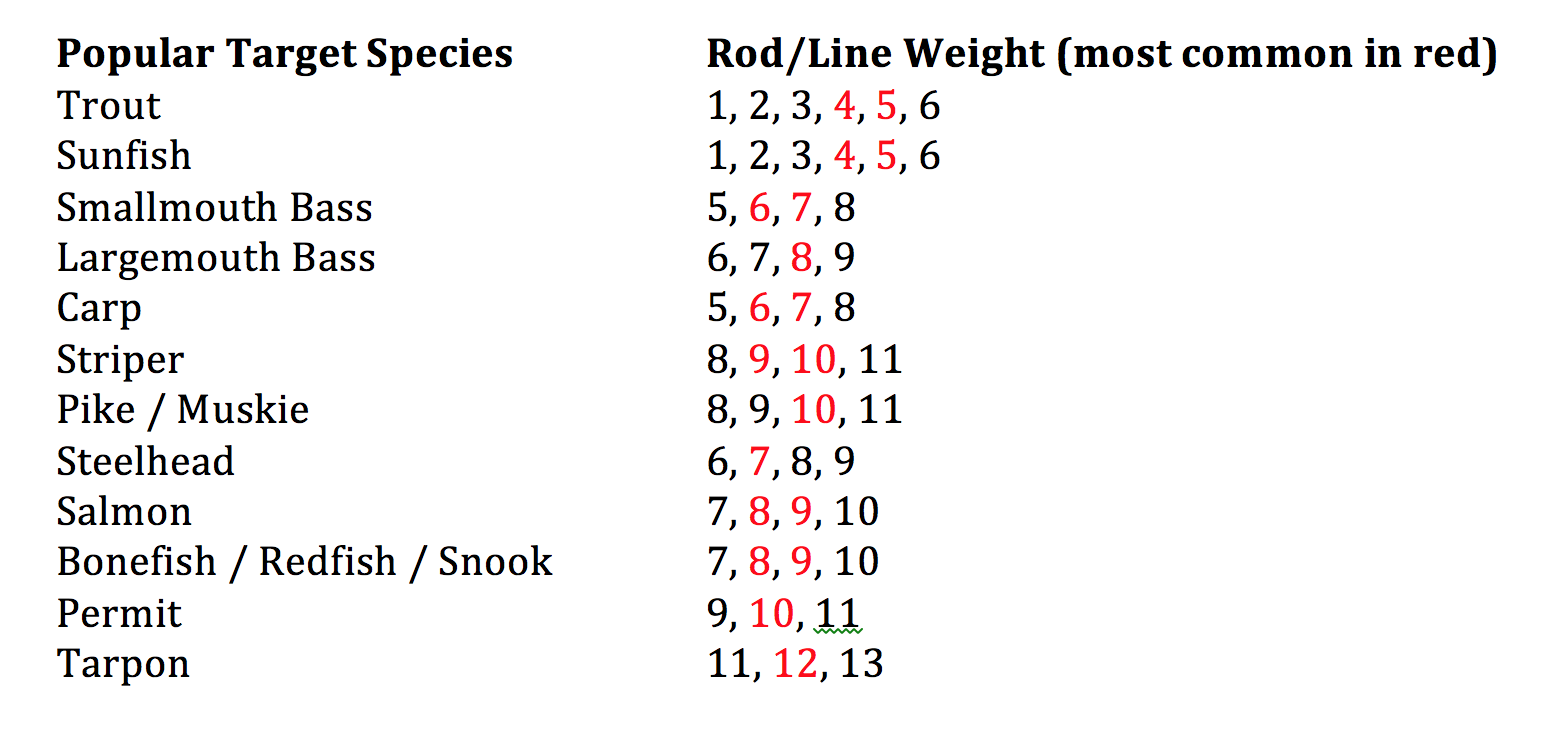 For trout, we are most often fishing with smaller flies on a dead drift. Lighter lines allow for a more delicate presentation and create less drag. On the other hand, when fishing for bass, we are often trying to “punch” flies into tight areas and quickly pull fish out of areas with a lot of woody structure. And we are typically using larger, heavier, wind-resistant flies. Often, there is simply not enough weight in a 4-weight line to effectively “turnover” a larger bass bug. Rather than the line carrying the fly on a level plane during the cast, the fly travels below the line, often catching the rod tip or worse, the back of your head!
For trout, we are most often fishing with smaller flies on a dead drift. Lighter lines allow for a more delicate presentation and create less drag. On the other hand, when fishing for bass, we are often trying to “punch” flies into tight areas and quickly pull fish out of areas with a lot of woody structure. And we are typically using larger, heavier, wind-resistant flies. Often, there is simply not enough weight in a 4-weight line to effectively “turnover” a larger bass bug. Rather than the line carrying the fly on a level plane during the cast, the fly travels below the line, often catching the rod tip or worse, the back of your head!
When you get into saltwater species and some large freshwater species like salmon, you may be choosing a particular rod and line weight because of the size of the fish more than the size of the fly. Yes, a 13-weight helps to cast bigger flies to tarpon, but mostly you need that size rod because its larger butt section will be necessary to fight a 150 pound fish!
The other thing that can necessitate a rod with a heavier line weight is wind. Saltwater species like bonefish, snook, redfish, etc. often aren’t particularly big and they don’t demand unusually large flies, but you encounter a lot of wind around the coast. In the American West, you tend to encounter more wind and may consequently want a 6-weight rod for trout. The accompanying chart lists appropriate rod/line weights for common game fish.
Compromise
So, you really need to consider what you’ll be fishing for and where you’ll be fishing to determine the best rod length and weight for your needs. In this part of the country, most people want to fish for bass and bluegill in streams, ponds and lakes, and they want to fish for trout in the mountains and tailwaters. But if you’re just getting into the sport, you probably don’t want to rush out and buy four different fly rod outfits. Fortunately, there is a middle ground.
If you’re the person described in the paragraph above, your ideal rod lengths might range from 7’ to 10’ and your ideal line weights might range from 4 to 7-weight. While it is impossible to get one rod that is perfect for everything, you can sometimes get one rod that is good enough for a lot of things. An 8 ½’ rod would be long enough to get by on bigger water and short enough to manage on smaller streams. A 5-weight would be light enough for trout fishing, ideal for bluegill, and adequate for bass fishing if you scale down your fly size.
Later, if you get really interested in bass fishing, maybe you add a 9’ 8-weight to your arsenal. Or if hiking into small brook trout streams becomes your thing, maybe you add a 7 ½’ 3-weight. You can certainly get by with one rod, but the more diverse your locations and species become, the more necessary it will be to have multiple rod sizes.
Fly Rod Action
Once you’ve narrowed down the rod size, it’s time to consider the action of the rod. Rods will typically be described as slow, medium, or fast. A slow action rod feels softer and more “noodly” because it flexes closer to the butt of the rod. A fast action fly rod will feel stiffer because it flexes closer to the tip of the rod. And as you might guess, a medium action rod sort of falls in between, flexing more in the middle of the rod.
Fast action rods are capable of generating more line speed and, in the right hands, more easily achieving greater casting distance. With their stiffer butt sections, they also tend to have more “backbone” when it comes to apply pressure when fighting fish. Most fly rods that are 7-weight or heavier will only be available in a fast action.
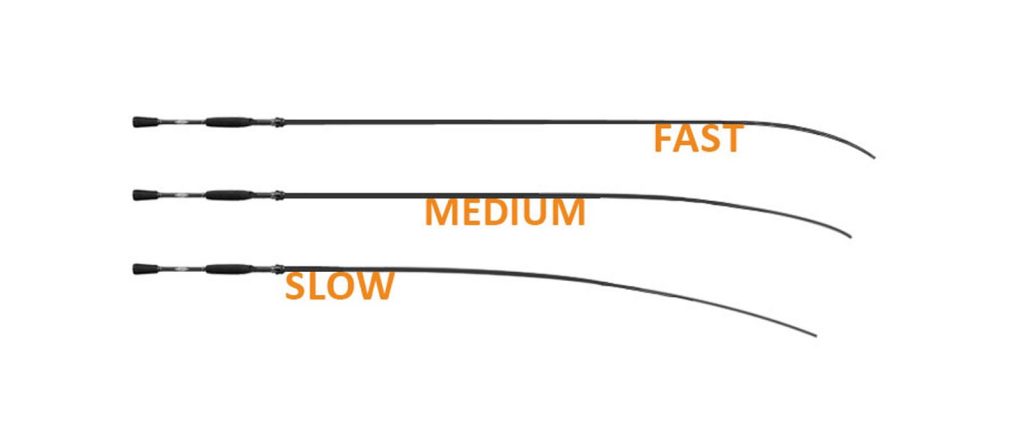 Slow action rods are more delicate in their delivery of the line and are more ideal for softer presentations. You tend to feel the fish more on a slow action rod and because it flexes much deeper in the rod, it is capable of better protecting very light tippets. Most rods in the 1 to 3-weight range are slower action rods. Typically, rods in the 4 to 6 weight range are available in a number of different actions.
Slow action rods are more delicate in their delivery of the line and are more ideal for softer presentations. You tend to feel the fish more on a slow action rod and because it flexes much deeper in the rod, it is capable of better protecting very light tippets. Most rods in the 1 to 3-weight range are slower action rods. Typically, rods in the 4 to 6 weight range are available in a number of different actions.
Your own personal casting style will also be a factor in the best rod action for you. People with a more aggressive casting stroke tend to favor a fast action rod. People with a more relaxed casting stroke tend to favor a slow action rod. Experienced fly casters can pretty easily adjust their casting stroke to the rod. If you’re new to fly fishing, you may not have enough experience to even know your preference. In that case, it’s usually safest to stick to the middle and go with a medium action rod.
Fly Rod Material and Price
 In the old days, fly rods were made from bamboo and their price depended on things like who made them and whether or not they were mass-produced. Some of the rods made by certain independent makers are extremely valuable today. Most of the bamboo rods that were mass-produced by larger companies have little value. Bamboo rods that are made today are mostly made by independent makers and have price tags in excess of $1000 largely because of the amount of time and craftsmanship that goes into making them.
In the old days, fly rods were made from bamboo and their price depended on things like who made them and whether or not they were mass-produced. Some of the rods made by certain independent makers are extremely valuable today. Most of the bamboo rods that were mass-produced by larger companies have little value. Bamboo rods that are made today are mostly made by independent makers and have price tags in excess of $1000 largely because of the amount of time and craftsmanship that goes into making them.
Today, bamboo rods definitely still have a following much like classic cars have a following. When compared to more “modern” materials, they tend to be a little heavier and almost every bamboo rod will fall into the slow action category. I wouldn’t recommend them to a beginner looking for a rod to get into the sport but for the more seasoned fly fishing enthusiast, they sure are cool!
Fiberglass replaced bamboo in the 50’s as the most common material for fly rods. It was lightweight, and after the trade embargo with China (where rod makers got their bamboo), it was far more available and cheaper to produce. Fiberglass rods have seen a recent return in popularity because of their soft, unique action (slow). Many large rod manufacturers are currently offering select models of fiberglass rods built with more modern components.
Most rods today are made from carbon fiber (graphite) and that has been the case for probably forty years. Carbon fiber is strong and much lighter than fiberglass or bamboo. It can be made in a number of different actions and it can be made in multiple pieces while still maintaining that action.
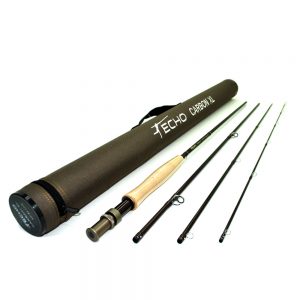 Bamboo rods, for instance, had/have metal ferrules (joints). To make a four-piece bamboo rod results not only in a lot of added weight, but “dead spots” at each of those joints. Carbon fiber rods have carbon fiber joints, allowing for a multi-piece rod that is still light and still maintains its action. Most carbon fiber rods today break down to four sections, allowing for easy storage and travel. Some break down into as many as seven pieces!
Bamboo rods, for instance, had/have metal ferrules (joints). To make a four-piece bamboo rod results not only in a lot of added weight, but “dead spots” at each of those joints. Carbon fiber rods have carbon fiber joints, allowing for a multi-piece rod that is still light and still maintains its action. Most carbon fiber rods today break down to four sections, allowing for easy storage and travel. Some break down into as many as seven pieces!
Today’s carbon fiber rods are priced all over the place. Some are mass-produced overseas using less expensive components (guides, reel seat, etc.) and can be found for well under $100. American made rods tend to start around $200. When you bump up to about $400, you’re getting a higher modulus graphite that will feel lighter and crisper – you’ll notice a difference. When you get into the real high-end stuff ($500-$1200), you are getting more technology as well as higher-end components, but most beginner to intermediate fly casters won’t be able to tell the difference.
Keep in mind that many of the things that influence the price of the rod won’t have anything to do with how it casts. For example, a mid to high end rod might have some exotic, $150 piece of wood used for the reel seat, while an entry level rod might use a $30 piece of walnut. One might use titanium for the guides while another might use stainless steel.
In other words, if you have the disposable income and want to spend $1200 on a rod, have at it. Just don’t expect it to necessarily cast better or catch more fish! Buy the best rod you can afford. There are some great rods in the $100 – $300 range, many with an unconditional guarantee. That’s right. Some of the major rod manufacturers provide an unconditional guarantee (or variation) on their rods. Orvis, for instance, offers a 25-year guarantee on all but one series of their rods. No matter how it breaks, they’ll fix it or replace it for 25 years! To me, it’s worth spending a little more to get a rod with a good warranty.
The bottom line is once you narrow down what size rod you need and what your budget is, it begins to boil down to personal preference. If you decide that an 8 ½’ 5-weight is what you need and you’re willing and able to spend up to $400 on it, go to the fly shop and cast every 8 ½’ 5-weight rod under $400 that they have. Any fly shop worth their salt will have a place for you to cast a rod and will gladly let you cast as many as you’d like. And when you do, one of them will just feel right.
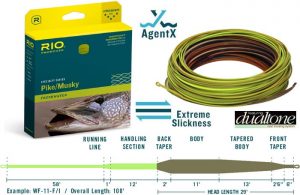 Floating fly lines are by far the most common, and for most trout fishing situations, they are all you need. When nymphing below the surface, weight in the fly or on the leader (split shot) is enough to get the fly and leader down where it needs to be. Doing this while the fly line is still floating can be advantageous as it allows the line to be mended when necessary and provides for quicker pick up when setting the hook on a dead drift. Even when fishing with streamers, a floating line is often adequate when stripping a weighted streamer through shallow trout streams.
Floating fly lines are by far the most common, and for most trout fishing situations, they are all you need. When nymphing below the surface, weight in the fly or on the leader (split shot) is enough to get the fly and leader down where it needs to be. Doing this while the fly line is still floating can be advantageous as it allows the line to be mended when necessary and provides for quicker pick up when setting the hook on a dead drift. Even when fishing with streamers, a floating line is often adequate when stripping a weighted streamer through shallow trout streams.

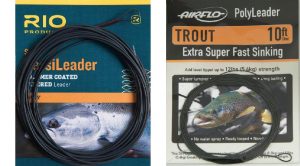 You can also find separate add-on sink tips to convert any floating line into a sink tip. This is convenient if you don’t want to carry an extra spool or if you don’t plan to fish sink tip lines frequently and don’t want the expense of an extra spool and line. However, my experience with these is that they hinge at the connection with the floating line and cast terribly.
You can also find separate add-on sink tips to convert any floating line into a sink tip. This is convenient if you don’t want to carry an extra spool or if you don’t plan to fish sink tip lines frequently and don’t want the expense of an extra spool and line. However, my experience with these is that they hinge at the connection with the floating line and cast terribly.
 As with most things in fly fishing, fishing packs and vests have come a long way over the years. The great thing about that is you now have a seemingly endless array of ways to carry and organize your on-stream tools and accessories. The bad thing is those seemingly endless choices can be a bit overwhelming.
As with most things in fly fishing, fishing packs and vests have come a long way over the years. The great thing about that is you now have a seemingly endless array of ways to carry and organize your on-stream tools and accessories. The bad thing is those seemingly endless choices can be a bit overwhelming.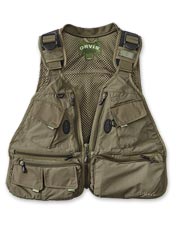 Vests: For decades, this has been the standard for carrying fly boxes, tools, etc. on the stream and while there have been some changes over the years, the basic concept is still the same and this is still the choice for many anglers. One of the greatest benefits of a vest is that with individual pockets for nearly everything, it’s really easy to keep things separated and organized. And the design of the vest is such that you can keep most of those items quickly and easily accessible. Most vests will also have larger compartments on the back for items that you may not need to access as frequently, like a rain jacket or lunch. D-rings on the back of a vest also make a great place to attach a net where its out of the way but easily accessible with the addition of a magnetic or clip attachment.
Vests: For decades, this has been the standard for carrying fly boxes, tools, etc. on the stream and while there have been some changes over the years, the basic concept is still the same and this is still the choice for many anglers. One of the greatest benefits of a vest is that with individual pockets for nearly everything, it’s really easy to keep things separated and organized. And the design of the vest is such that you can keep most of those items quickly and easily accessible. Most vests will also have larger compartments on the back for items that you may not need to access as frequently, like a rain jacket or lunch. D-rings on the back of a vest also make a great place to attach a net where its out of the way but easily accessible with the addition of a magnetic or clip attachment.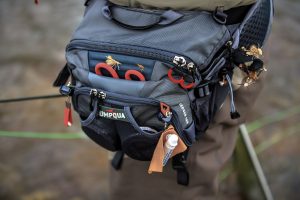 Hip Packs: These are often worn around the waist on the rear when not fishing, and rotated to the hip when accessing items in the pack. Probably their greatest advantage is that they stay out of your way when fishing and offer total freedom of movement when casting, etc. There are also accessories you can add (or may be built in to some packs) for carrying a net.
Hip Packs: These are often worn around the waist on the rear when not fishing, and rotated to the hip when accessing items in the pack. Probably their greatest advantage is that they stay out of your way when fishing and offer total freedom of movement when casting, etc. There are also accessories you can add (or may be built in to some packs) for carrying a net. Chest Packs: These, as the name implies, are designed to be worn on the chest and come in a number of sizes. They organize things in much the same way a hip pack does but keep things far more accessible on your chest and high out of the water. Many will have a D-ring on the rear of the neck strap for carrying a net. I would include a chest fly box (like I use) in the same category as a chest pack, except that there is no need for separate fly boxes.
Chest Packs: These, as the name implies, are designed to be worn on the chest and come in a number of sizes. They organize things in much the same way a hip pack does but keep things far more accessible on your chest and high out of the water. Many will have a D-ring on the rear of the neck strap for carrying a net. I would include a chest fly box (like I use) in the same category as a chest pack, except that there is no need for separate fly boxes.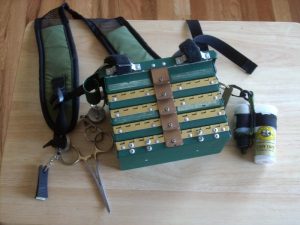
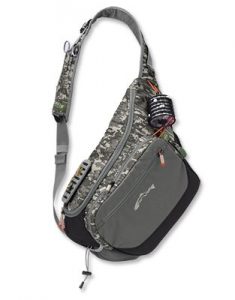 Sling Packs: These are the latest trend in fishing packs and are designed to be more accessible than a hip pack and more out of the way than a chest pack. They are worn diagonally across your body so that they can be easily “slung” around to your front when you need to get to it. It can then be “slung” around and secured out of the way on your back when you’re fishing. They come in small and large sizes depending on how much you need to carry.
Sling Packs: These are the latest trend in fishing packs and are designed to be more accessible than a hip pack and more out of the way than a chest pack. They are worn diagonally across your body so that they can be easily “slung” around to your front when you need to get to it. It can then be “slung” around and secured out of the way on your back when you’re fishing. They come in small and large sizes depending on how much you need to carry.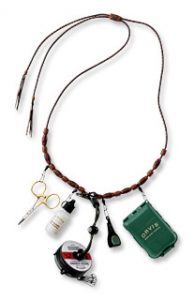 Lanyard: A fishing lanyard is basically a necklace for carrying your essentials around your neck. Most will comfortably carry and organize nippers, forceps, tippet, floatant and small fly box. By itself, this is for the absolute minimalist. For others, it may be a way to keep essential, frequently used items immediately accessible while carrying other less frequently used items in a hip pack or backpack.
Lanyard: A fishing lanyard is basically a necklace for carrying your essentials around your neck. Most will comfortably carry and organize nippers, forceps, tippet, floatant and small fly box. By itself, this is for the absolute minimalist. For others, it may be a way to keep essential, frequently used items immediately accessible while carrying other less frequently used items in a hip pack or backpack.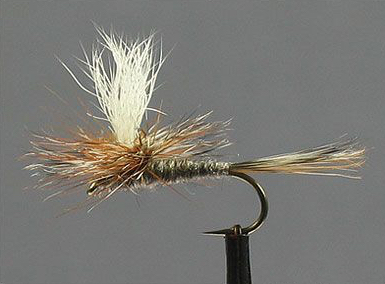
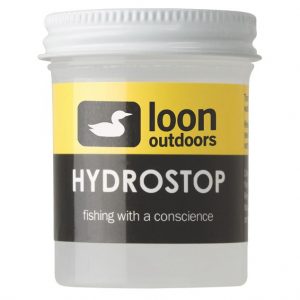 While many anglers use them in different ways, liquid floatants are probably most useful before you ever get to the stream. Whether dry flies that you tie yourself or buy from a shop, you can use a liquid style floatant to “pre-treat” new flies in much the same way as you might “Scotchgard” your sofa. Exact application may vary and you should read the recommendations for the specific brand you purchase, but typically, flies will be soaked in the liquid for five minutes or so and then set out to dry overnight. In theory, after application of the product, water will better bead and roll of the fly material rather than absorb into it.
While many anglers use them in different ways, liquid floatants are probably most useful before you ever get to the stream. Whether dry flies that you tie yourself or buy from a shop, you can use a liquid style floatant to “pre-treat” new flies in much the same way as you might “Scotchgard” your sofa. Exact application may vary and you should read the recommendations for the specific brand you purchase, but typically, flies will be soaked in the liquid for five minutes or so and then set out to dry overnight. In theory, after application of the product, water will better bead and roll of the fly material rather than absorb into it.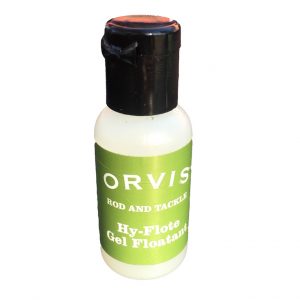 Gel floatants are probably the most common and popular style of floatant. They come in a small, very portable bottle and, like the liquid floatants, are designed to be a pre-treatment to an already dry fly. The big difference is gel floatants are designed to be used streamside, immediately before fishing the fly.
Gel floatants are probably the most common and popular style of floatant. They come in a small, very portable bottle and, like the liquid floatants, are designed to be a pre-treatment to an already dry fly. The big difference is gel floatants are designed to be used streamside, immediately before fishing the fly.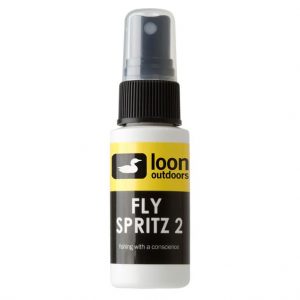 Also normally applied while the fly is still dry, spray floatants are basically just a variation on a gel floatant. Spray floatants come in a bottle with a pump top and are applied much like you would spray something like an eyeglass cleaner. They are not as messy as the gel but are sometimes more challenging to completey coat the fly.
Also normally applied while the fly is still dry, spray floatants are basically just a variation on a gel floatant. Spray floatants come in a bottle with a pump top and are applied much like you would spray something like an eyeglass cleaner. They are not as messy as the gel but are sometimes more challenging to completey coat the fly.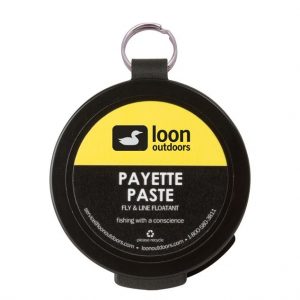 These are basically just a thicker version of a gel floatant. They can really create a mess on smaller dry flies and are probably best suited for larger dries like hoppers and stoneflies. A lot of people prefer a paste floatant to apply to yarn strike indicators or even on a leader to keep it floating better.
These are basically just a thicker version of a gel floatant. They can really create a mess on smaller dry flies and are probably best suited for larger dries like hoppers and stoneflies. A lot of people prefer a paste floatant to apply to yarn strike indicators or even on a leader to keep it floating better.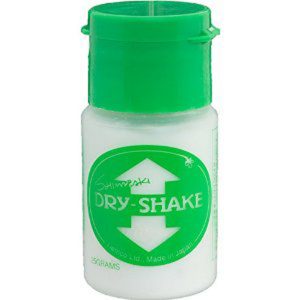 These are used less as a pre-treatment and more as a means to revive a saturated fly. As mentioned above, when a dry fly becomes oversaturated and begins to sink, applying a gel or spray can often make it worse by trapping moisture in. Powder floatants are used to absorb and remove that moisture from a fly.
These are used less as a pre-treatment and more as a means to revive a saturated fly. As mentioned above, when a dry fly becomes oversaturated and begins to sink, applying a gel or spray can often make it worse by trapping moisture in. Powder floatants are used to absorb and remove that moisture from a fly.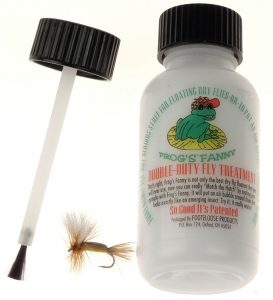 Brush floatants are essentially another version of a powder floatant. Rather than shaking the fly inside the bottle, a small brush is used to apply the powder to the fly. Again, it’s personal preference but with brush floatants, be prepared for a little frustration on windy days!
Brush floatants are essentially another version of a powder floatant. Rather than shaking the fly inside the bottle, a small brush is used to apply the powder to the fly. Again, it’s personal preference but with brush floatants, be prepared for a little frustration on windy days!
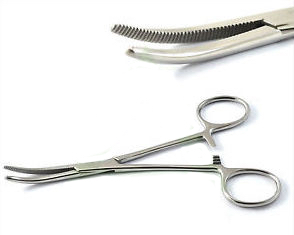
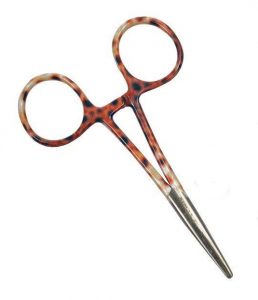
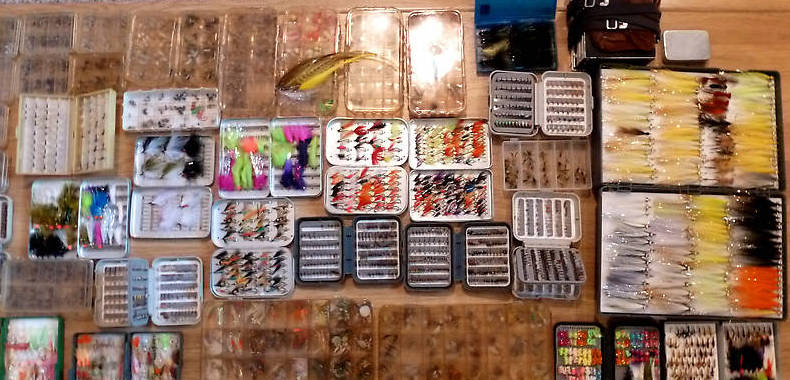 I’m a bit of an oddball. This is not exactly breaking news for most folks who know me. But to paraphrase John Gierach, “If, from time to time, people don’t walk away from you shaking their head… You’re doing something wrong.” I could certainly dedicate an entire article, or even a book, to my oddball qualities, but for this article, I am referring to one specific oddball quality. I fish and guide with a set-up that combines a pack and fly boxes all in one contraption. You’ve seen it. It’s my chest fly box, custom built by the
I’m a bit of an oddball. This is not exactly breaking news for most folks who know me. But to paraphrase John Gierach, “If, from time to time, people don’t walk away from you shaking their head… You’re doing something wrong.” I could certainly dedicate an entire article, or even a book, to my oddball qualities, but for this article, I am referring to one specific oddball quality. I fish and guide with a set-up that combines a pack and fly boxes all in one contraption. You’ve seen it. It’s my chest fly box, custom built by the 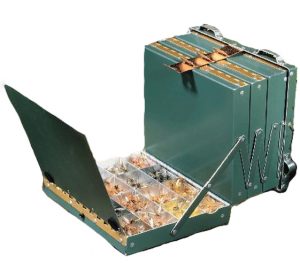
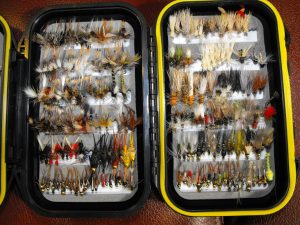
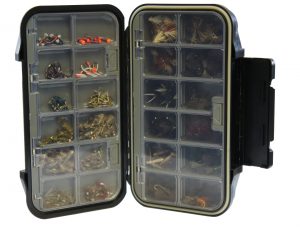
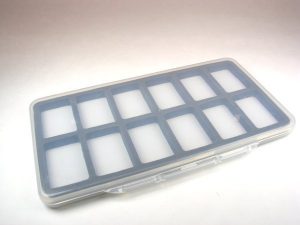
 This should probably go without saying, but the fly rod is the tool used to cast the line when fly fishing. It is also used to manipulate line on the water after the cast, to set the hook on a fish (usually), and to fight the fish after hooking it. It is certainly one of the most important pieces of your equipment and likely the piece of equipment in which you’ll invest the most money. So, what do you need to consider before making this investment? The three most important characteristics of a fly rod are its length, its line weight designation, and its action.
This should probably go without saying, but the fly rod is the tool used to cast the line when fly fishing. It is also used to manipulate line on the water after the cast, to set the hook on a fish (usually), and to fight the fish after hooking it. It is certainly one of the most important pieces of your equipment and likely the piece of equipment in which you’ll invest the most money. So, what do you need to consider before making this investment? The three most important characteristics of a fly rod are its length, its line weight designation, and its action. For trout, we are most often fishing with smaller flies on a dead drift. Lighter lines allow for a more delicate presentation and create less drag. On the other hand, when fishing for bass, we are often trying to “punch” flies into tight areas and quickly pull fish out of areas with a lot of woody structure. And we are typically using larger, heavier, wind-resistant flies. Often, there is simply not enough weight in a 4-weight line to effectively “turnover” a larger bass bug. Rather than the line carrying the fly on a level plane during the cast, the fly travels below the line, often catching the rod tip or worse, the back of your head!
For trout, we are most often fishing with smaller flies on a dead drift. Lighter lines allow for a more delicate presentation and create less drag. On the other hand, when fishing for bass, we are often trying to “punch” flies into tight areas and quickly pull fish out of areas with a lot of woody structure. And we are typically using larger, heavier, wind-resistant flies. Often, there is simply not enough weight in a 4-weight line to effectively “turnover” a larger bass bug. Rather than the line carrying the fly on a level plane during the cast, the fly travels below the line, often catching the rod tip or worse, the back of your head! Slow action rods are more delicate in their delivery of the line and are more ideal for softer presentations. You tend to feel the fish more on a slow action rod and because it flexes much deeper in the rod, it is capable of better protecting very light tippets. Most rods in the 1 to 3-weight range are slower action rods. Typically, rods in the 4 to 6 weight range are available in a number of different actions.
Slow action rods are more delicate in their delivery of the line and are more ideal for softer presentations. You tend to feel the fish more on a slow action rod and because it flexes much deeper in the rod, it is capable of better protecting very light tippets. Most rods in the 1 to 3-weight range are slower action rods. Typically, rods in the 4 to 6 weight range are available in a number of different actions. In the old days, fly rods were made from bamboo and their price depended on things like who made them and whether or not they were mass-produced. Some of the rods made by certain independent makers are extremely valuable today. Most of the bamboo rods that were mass-produced by larger companies have little value. Bamboo rods that are made today are mostly made by independent makers and have price tags in excess of $1000 largely because of the amount of time and craftsmanship that goes into making them.
In the old days, fly rods were made from bamboo and their price depended on things like who made them and whether or not they were mass-produced. Some of the rods made by certain independent makers are extremely valuable today. Most of the bamboo rods that were mass-produced by larger companies have little value. Bamboo rods that are made today are mostly made by independent makers and have price tags in excess of $1000 largely because of the amount of time and craftsmanship that goes into making them. Bamboo rods, for instance, had/have metal ferrules (joints). To make a four-piece bamboo rod results not only in a lot of added weight, but “dead spots” at each of those joints. Carbon fiber rods have carbon fiber joints, allowing for a multi-piece rod that is still light and still maintains its action. Most carbon fiber rods today break down to four sections, allowing for easy storage and travel. Some break down into as many as seven pieces!
Bamboo rods, for instance, had/have metal ferrules (joints). To make a four-piece bamboo rod results not only in a lot of added weight, but “dead spots” at each of those joints. Carbon fiber rods have carbon fiber joints, allowing for a multi-piece rod that is still light and still maintains its action. Most carbon fiber rods today break down to four sections, allowing for easy storage and travel. Some break down into as many as seven pieces!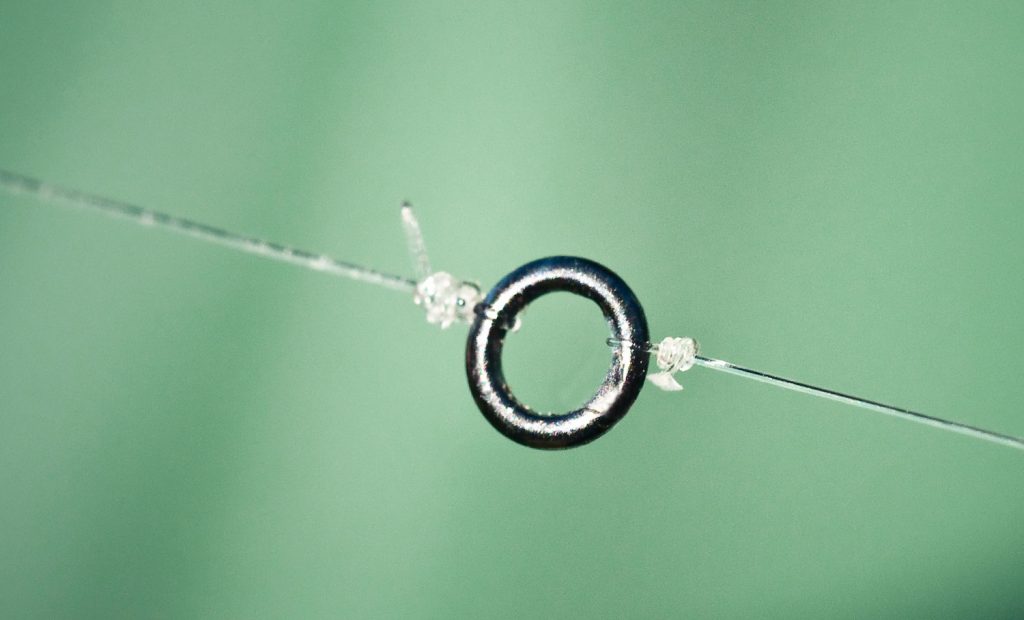 Over the last few years, tippet rings have been gaining more and more popularity and acceptance. Most new fly fishermen love them. Most traditionalists hate them. What are they?
Over the last few years, tippet rings have been gaining more and more popularity and acceptance. Most new fly fishermen love them. Most traditionalists hate them. What are they?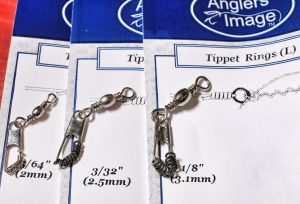
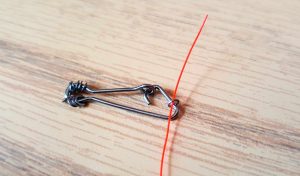
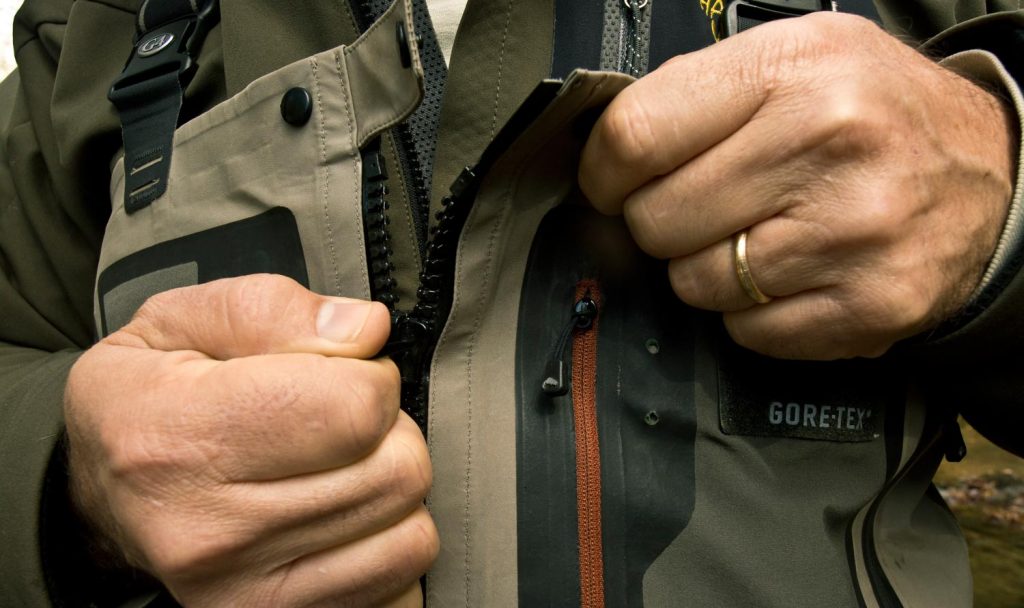 October is the time of year I start wearing waders again in the mountains. For much of the year, usually from May through October, water temperatures are comfortable enough to wet wade, wearing only the wading boots and neoprene socks. But in winter, early spring, and late fall (or any time of year on tailwaters), you better have a decent set of waders if you want to stay comfortable on the stream.
October is the time of year I start wearing waders again in the mountains. For much of the year, usually from May through October, water temperatures are comfortable enough to wet wade, wearing only the wading boots and neoprene socks. But in winter, early spring, and late fall (or any time of year on tailwaters), you better have a decent set of waders if you want to stay comfortable on the stream.

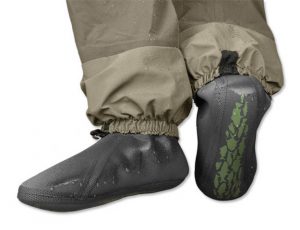
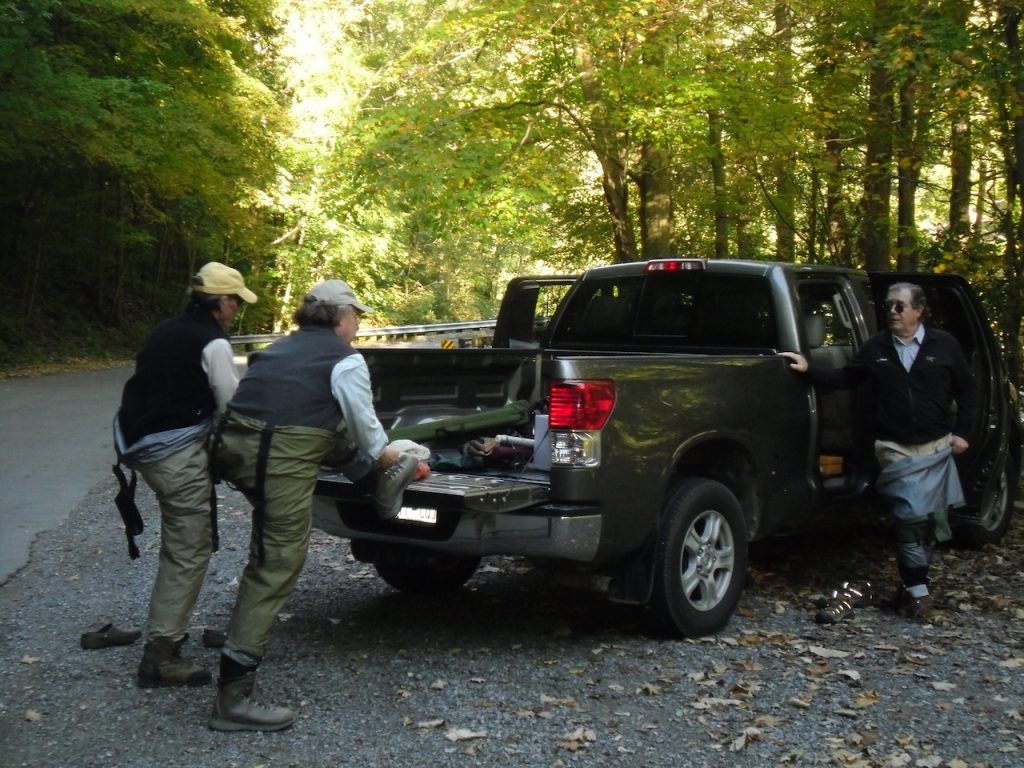 When I first got into fly fishing, I didn’t have any money. At that age, you simply had to get what you could get when you could get it, and that often meant holding out until birthday or Christmas. I had a cheap rod and reel outfit and a box of flies. My fishing “vest” was my uncle’s old Marines shirt with the sleeves cut off. The bellows pockets on the front were plenty big to hold my one fly box and any other accessories. And I had a pair of fingernail clippers, Trim brand, hung around my neck on a piece of fly line. My wading gear consisted of cutoff Duckhead shorts and an old pair of Asics running shoes.
When I first got into fly fishing, I didn’t have any money. At that age, you simply had to get what you could get when you could get it, and that often meant holding out until birthday or Christmas. I had a cheap rod and reel outfit and a box of flies. My fishing “vest” was my uncle’s old Marines shirt with the sleeves cut off. The bellows pockets on the front were plenty big to hold my one fly box and any other accessories. And I had a pair of fingernail clippers, Trim brand, hung around my neck on a piece of fly line. My wading gear consisted of cutoff Duckhead shorts and an old pair of Asics running shoes.
